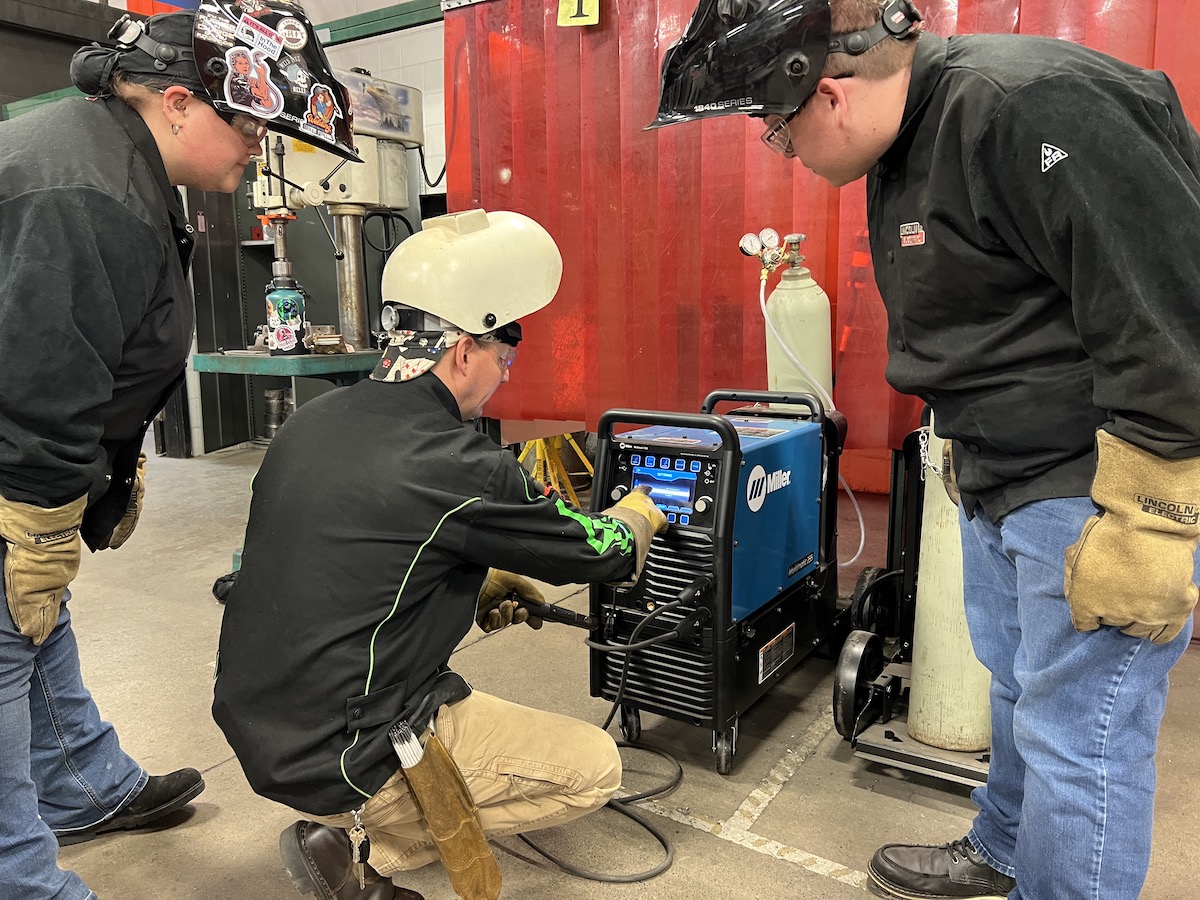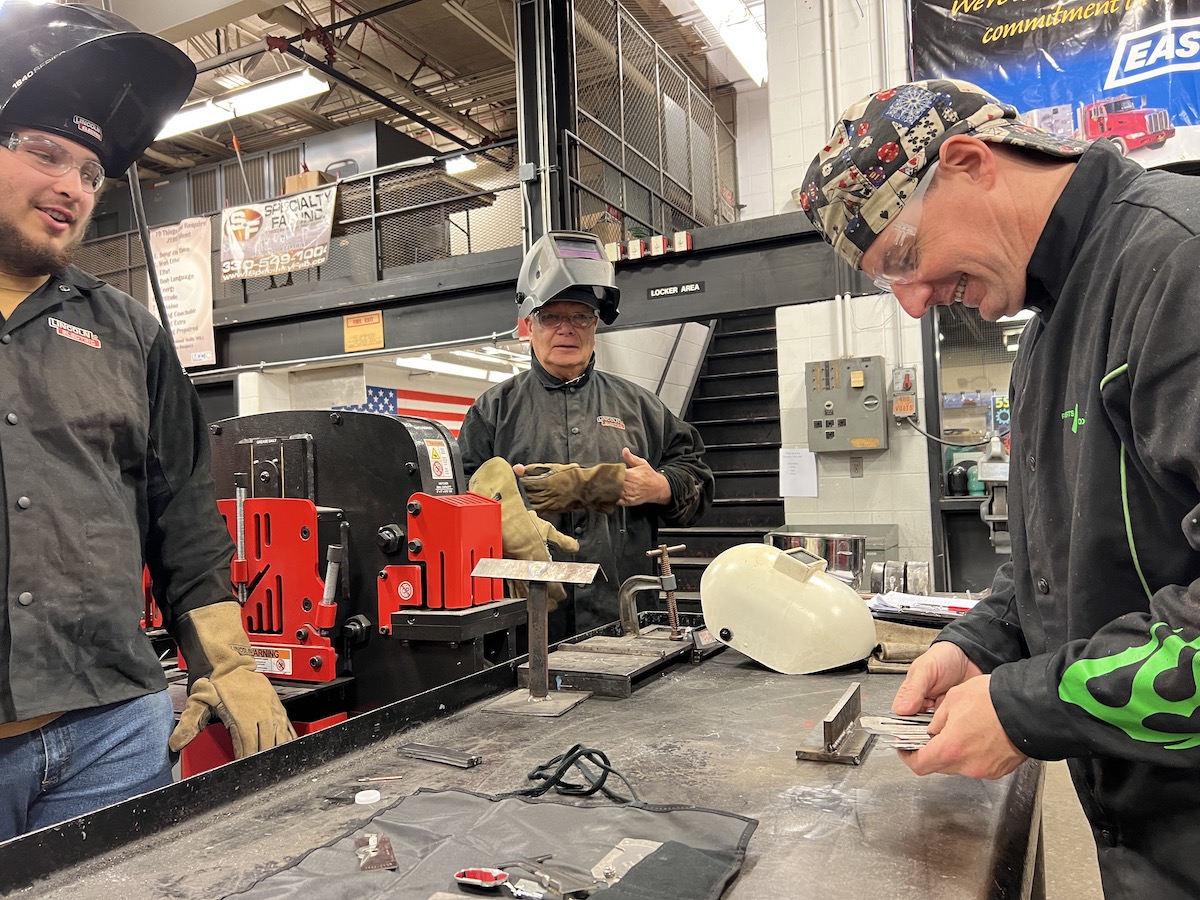Jump to:
How to Make a Quality Shielded Metal Arc Weld
Welding student Mason Blaine performs a fillet weld on a T-joint while welding instructor Brian Wall watches his in-process bead placement. Pictures by Jodi Glass.
Shielded metal arc welding (SMAW) is known as the grandfather of welding for its longevity in the industry. It earned that distinction because few processes are as versatile or accessible. A basic setup requires an electrode, an electrode holder, a ground clamp, a welding cable, and a constant current. It can run from a transformer rectifier used to tinker in the garage or off the front of a heavy-duty generator yards away from its power source. Either setup gives a welder the ability to join a variety of metals in locations other processes cannot.
SMAW bead placement requires the right combination of amperage, polarity, and arc length as well as a steady hand at the precise moment. Mastering these techniques requires a solid educational foundation.
At Mahoning County Career & Technical Center, Canfield, Ohio, the first welding process a student learns is SMAW. The curriculum stresses the importance of adhering to code and reinforces techniques that conform to codes and standards.

Lesson 1: Amperage
The class curriculum uses both an E6010 electrode and a low-hydrogen E7018. To set up the machine, a student must first learn how to choose a polarity and amperage. To find a good starting amperage, students are taught how to take the nominal diameter of the electrode. The student learns to convert the nominal diameter from a fraction to a decimal using a basic math method: dividing the numerator by the denominator. The decimal is then used as a guide to set the amperage. For example, if the student is using a 3/32-in. electrode, which is converted to 0.09375 in. when dividing the numerator by the denominator, then 93 A is their starting point. Students should have a basic understanding of this math equation before advancing to a welding procedure specification (WPS). Navigating a WPS to find amperages and other weld parameters is also key to a welder's education.
Lesson 2: Technique
There are many techniques used to create a quality weld. First, students are taught different ways to initiate the arc. Students are trained how to start the arc using a scratch start or tap technique. They are also instructed on how and why to avoid arc strike marks, which can be rejectable by code. The stringer bead method introduces the student to a weld bead. Both the E6010 and E7018 electrodes are used for this, and students are taught the proper care and handling of the different types of electrodes. The stringer bead helps students master arc length, work angle, and travel speed and their effects on the pool. After the stringer bead, techniques are built around different types of weave patterns and weld pool manipulations. The U, J, or circular pattern are some of the patterns introduced. Referencing section 5.30 of the D1.1 standard, the students are then instructed on the requirements for cleaning their welds. Instruction continues with a 1-in. weld coupon, which shows students what a weld bead sequence looks like and helps with bead placement.
Lesson 3: Technology
The machines at the school are equipped with technology that enables the instructor to introduce the intricacies of each technology and how each affects the SMAW process. Learning about arc force control, or dig function, is a tangible transition to explaining arc voltage and how it affects the pool and final bead. Other advantages of this control are the following: It helps prevent sticking when the arc length is too short; it improves the control of the pool when welding out of position; and with that added control of the molten pool, it can help reduce or eliminate undercutting. The hot start function is another piece of technology that we bring to students. The additional current that is brought to the electrode helps with a quick, reliable start with both the scratch and tapping method. The extra current on a hot start can help with tie-ins on previous welds or tack welds. Both these functions have their advantages and disadvantages but making students aware of them adds a depth in their understanding of welding and some of the technology in the welding industry today.

Lesson 4: Quality
To make a quality SMAW bead, the definition of a quality bead must be established. Students are trained to do visual inspections of their own welds by identifying weld discontinuities and rejectable defects. They use a variety of nondestructive examination gauges to appraise their work. Coupled with a lab class standard that mirrors the visual criteria set by the D1.1 structural code, the student and instructor can assess the weld and look for corrective actions and root causes for discontinuities that may need to be addressed. Weld bead profiles are also appraised. Leg and throat sizes for fillet welds and weld reinforcement for butt joints are also assessed and used to further educate students. The knowledge of what a good bead looks like transfers strongly to the way a student applies what they have learned while making SMA welds.

Conclusion
SMAW is the fundamental building block to a career in welding. It introduces principles that become rudimentary in all other welding processes. Knowing what a quality bead is and how to make a quality weld are the cornerstones of any welding career. Adding elements of technology that manufacturers have included on their machines keeps one of the oldest welding processes current and viable in the welding industry. SMAW is the gateway to many opportunities, and it all starts with knowing how to put down a quality SMA weld.
This article was written by Brian Wall (a welding instructor at Mahoning County Career & Technical Center, Canfield, Ohio) for the American Welding Society.


